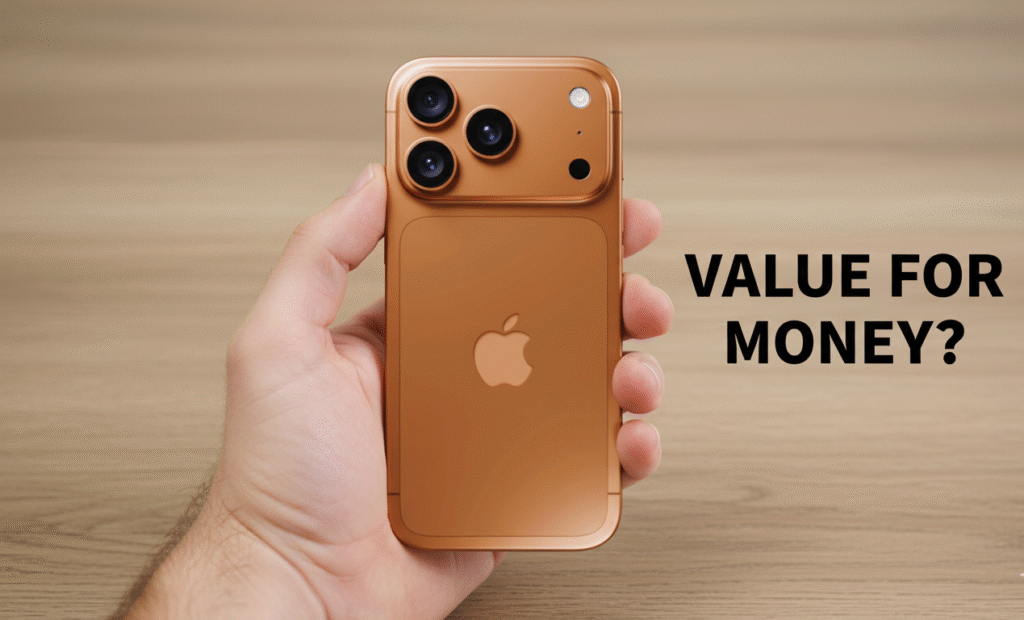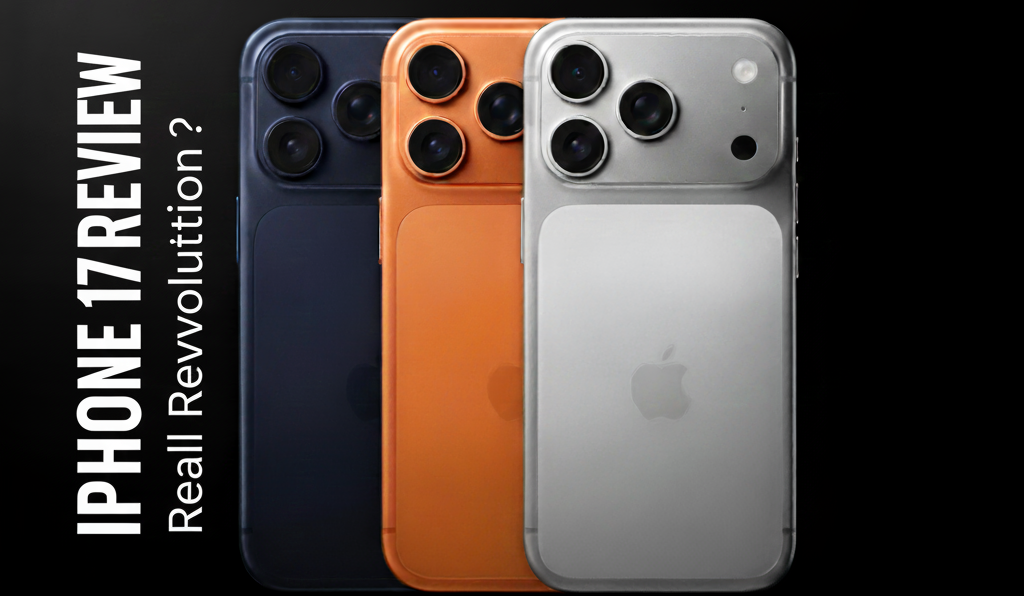Apple has just launched thinner, shinier, tougher, loaded with new A19 chip, thee brand new iPhone 17. The crowd clapped, the stage looked slick, and the titanium frame caught the lights just right. But here’s the real question: is this actual innovation, or just the same old iPhone story with a fresh coat of polish? For all the branding of a “new era,” the tale is oddly old, polished upgrades paraded as ground-breaking change.
iPhone 17 Design: Premium Déjà Vu in Titanium
At first glance, the iPhone 17 design looks… oddly familiar. Apple hypes its titanium build and thinner profile as if it’s design wizardry, but in reality, it feels like déjà vu dressed in marketing slides. The irony? This “modern design” looks suspiciously similar to the kind of copycat attempt you’d expect from a budget Android brand desperately trying to mimic the iPhone’s aura. You know the type phones that slap on a shiny finish, slim bezels, and oversized camera bumps just to make their users feel like they’re holding something premium.
Only difference? Apple’s version isn’t cheap. It’s the same story, just with a price tag that screams exclusivity. Real clownery, if you ask me.

iPhone 17 Performance: The “Innovation” Pitch
Apple proudly waved its new A19 chip on stage, promising faster speeds, smoother graphics, and better battery efficiency. Sounds impressive! But just until you realize it’s the exact same sales pitch we’ve been hearing every September since the iPhone 6. The numbers get bigger, the slides get flashier, but the real-world difference? Almost invisible for the average user.
And yet, here come the faithful iPhone devotees, clapping like seals at a circus, ready to camp outside Apple Stores for a device that does almost the same thing their current phone does. Apple sells “innovation,” but what it’s really mastered is selling the feeling of innovation. The fans don’t just buy a phone; they buy the story, the illusion. And they wear it proudly, like a badge of premium clownery.
The “Real” Improvements (If You Can Call Them That)
To be fair, Apple did sprinkle in some genuine upgrades at the Apple September 2025 event. The iPhone 17 Pro models now pack the A19 Pro chip, complete with a fancy vapor chamber that keeps the phone cool while you play Candy Crush like a “pro gamer.” Supposedly, this makes it the fastest iPhone ever, but then again, isn’t that what Apple claims every single year?
The cameras? Oh yes, now you’ve got “three 48MP Fusion lenses” with up to 8x optical zoom. Sounds impressive, until you remember Android phones, Xiaomi and Samsung, to name a few have already been flaunting 200MP sensors like it’s no big deal. Apple arrives late to the game, waves around its 48MP lenses as if it just invented photography, and the audience still claps. The new 18MP Center Stage selfie camera is great too, finally giving influencers the chance to look like high-definition clowns on TikTok.
Battery life has also “dramatically improved,” thanks to that vapor chamber design and a slightly bigger cell. Translation: maybe you’ll squeeze out an extra hour of doomscrolling before bedtime. Revolutionary, right?
And let’s not forget the Ceramic Shield 2, now protecting both front and back. Apple swears it’s 3x more scratch-resistant and 4x better at resisting cracks. Which is wonderful, because it means when you inevitably drop your $1,200 device, the glass will only shatter into smaller, shinier pieces.
So yes, on paper, the iPhone 17 features really do make it Apple’s “best iPhone ever.” But that’s not saying much, it’s like being crowned the tallest clown at the circus.

iPhone 17 Price: The True Premium Clownery
And of course, no Apple event would be complete without the grand finale — the iPhone 17 price. The phone starts at a “modest” $1,199, with the Pro Max variant climbing into laptop territory. Add in accessories like AirPods and a charger (yes, still sold separately), and suddenly you’re paying the kind of money that could buy you a decent gaming PC or a round-trip flight abroad.
But here’s the genius of Apple: the higher the price, the more loyal fans see it as proof of quality. They don’t just buy a phone — they buy a status symbol, a piece of identity. To Apple, it’s not about selling technology; it’s about selling belonging. And the fans, with wallets wide open, don’t even realize they’re paying premium for evolution disguised as revolution.
Why Apple Still Wins (The Psychology of the Circus)
Here’s the irony: Apple doesn’t even need to reinvent the wheel. Its customers are already locked into the ecosystem. AirPods, Apple Watch, iCloud, iMessage, escaping feels like social exile. Add in the flawless marketing machine that convinces you a slightly brighter display is the “future of vision,” and suddenly, rational thought goes out the window. It’s not the concept of innovation that keeps Apple on top, itis actually the psychology, prestige, and that unspoken badge of “belonging” when you pull out the latest iPhone in public. In short, Apple isn’t just selling a phone, it’s selling a personality upgrade.
So, is the iPhone 17 a bad phone? Not at all. It’s sleek, powerful, and reliable. Reliable? Not too sure! But is it the groundbreaking innovation Apple wants you to believe? Not even close. What it really is… is another chapter in the same old story, a shiny new crown for the tallest clown in the circus.
Also Read: ios 18.4 beta 2 for iPhone 16e: Released with New Emojis and CarPlay Updates!
The iPhone 17 brings a titanium frame, A19 chip, upgraded 48MP cameras, and Ceramic Shield 2. Sounds fresh, but it’s mostly old tricks polished with new marketing.
The iPhone 17 starts at $1,199, with the Pro Max reaching laptop-level pricing. Accessories like AirPods and the charger are still sold separately.
Apple added three 48MP Fusion lenses and up to 8x optical zoom. Impressive on paper, but competitors like Samsung and Xiaomi already flaunt 200MP sensors.
Apple claims improved battery thanks to a vapor chamber and larger cell. In reality, expect maybe an extra hour of doomscrolling before bed.
Apple’s secret weapon isn’t specs—it’s ecosystem lock-in, marketing psychology, and brand prestige. Basically, Apple sells belonging, not just phones.
If you’re already deep in the Apple ecosystem, you probably will anyway. But if you’re looking for real innovation, plenty of Android phones beat it on specs and price.What is new in the iPhone 17?
How much does the iPhone 17 cost?
Is the iPhone 17 camera really an upgrade?
Does the iPhone 17 have better battery life?
Why do people still buy iPhones if the upgrades are small?
Should I upgrade to the iPhone 17?





















